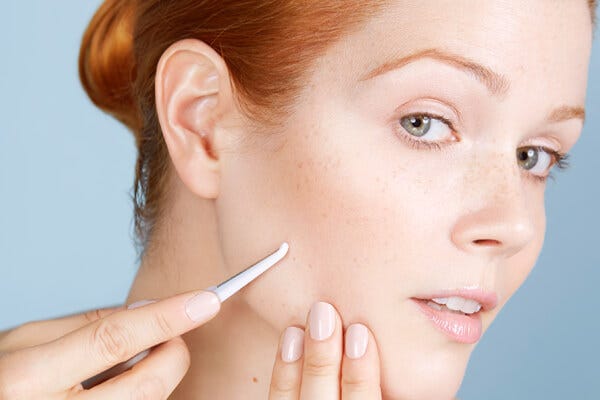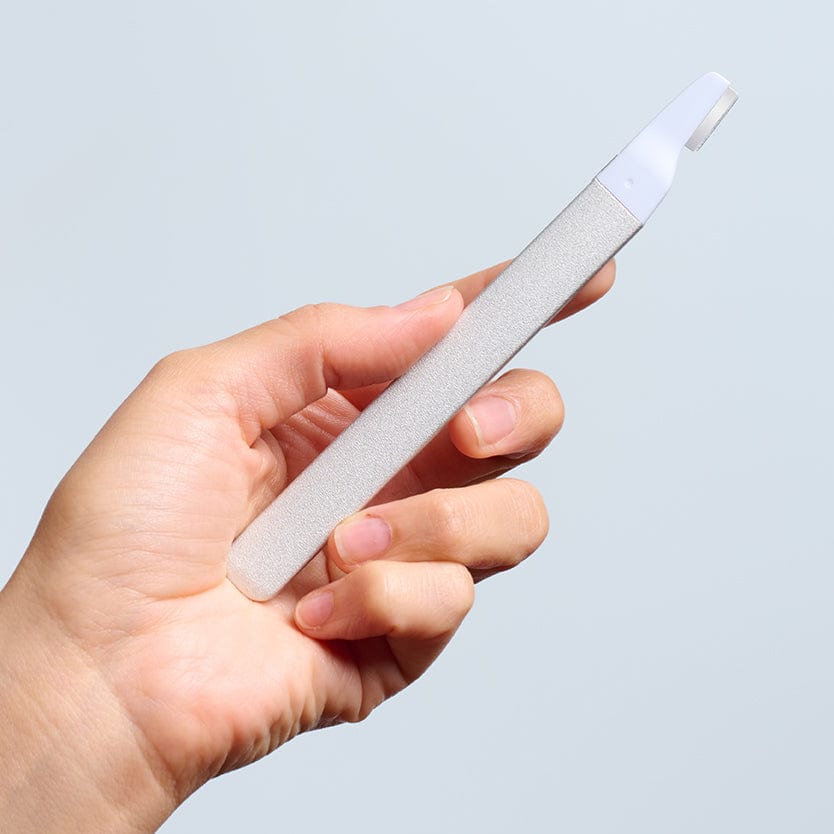Dermaplaning: Exfoliation For Instantly Improved Skin
Written by Kerry Benjamin

What Is Dermaplaning?
Dermaplaning is a manual exfoliation treatment where dead skin and vellus hair (peach fuzz) is removed using a sterile blade. Dermaplaning has been performed for decades but gained prominence in medispas in the 1990s.
Dermaplaning was once only performed by licensed professionals like dermatologists and aestheticians, but thanks to new, safe, easy-to-use tools like our Dermaplaning Tool, you can now perform the treatment yourself.
Dermaplaning is safe and pain-free (it feels like a tickling or light brushing). Most skin types can benefit from dermaplaning, and it’s safe for men and women of all ethnicities and ages—even for pregnant or nursing women.
Benefits of Dermaplaning:
ENHANCED PRODUCT PENETRATION
One of the greatest benefits of this superficial exfoliation treatment is its ability to promote deeper, more even penetration of active products like serums.
REMOVAL OF HAIR
The temporary removal of “peach fuzz” creates a brighter and smoother skin tone and texture.
SMOOTHER MAKEUP APPLICATION
Dermaplaning creates a smoother canvas for makeup application. This is thanks to the removal of fine facial hair and excess dead skin which can hold onto foundation and make it look uneven and blotchy.
INCREASE MATRIX PROTEINS
Matrix proteins, such as collagen and elastin, are largely responsible for the visible signs of aging. The exfoliation of the skin from dermaplaning promotes the production of collagen and elastin, helping to improve the appearance of signs of aging and scarring.
HYPERKERATOSIS REDUCTION
Hyperkeratosis is a buildup of dead skin on the outermost layer of your epidermis. That buildup causes dullness, ineffective product penetration, and acne. Dermaplaning reduces the thickness of the outer layer of the skin to correct those skin conditions, while increasing the thickness of the remaining epidermis and dermis.
IMPROVE HYPERPIGMENTATION
Dermaplaning is most beneficial for hyperpigmentation because of its ability to increase penetration of products that inhibit the production of melanin such as hydroquinone, kojic acid, lactic acid and retinols.
ACNE SIMPLEX REDUCTION
Non-pustular and non-inflamed acne respond very well to this treatment. The removal of the outer layer prevents breakouts and enhances the penetration of topical acne products. However, you should never dermaplane across an active breakout.
How Does Dermaplaning Work?
Our Dermaplaning Tool is used on clean, dry skin on the forehead, cheeks, chin, nose and neck. As it gently skims the surface of the skin, the blade removes dry skin cells and fine hair. Like many exfoliation techniques, dermaplaning “tricks” the body into thinking it has undergone injury and needs to repair itself; therefore, the skin creates newer, healthier cells. The result is brighter, smoother skin with a reduction in fine lines, hyperpigmentation, and breakouts with continued use.
How Do I Do It Myself?
Our patented Dermaplaning Tool was designed to give you the same results as an in-office treatment with safety features that make it easy to do it yourself. It’s safe to use up to once a week and can be used with your other StackedSkincare tools, serums, and peels.
Beginning at the top of the cheekbone near the hairline, hold your skin taut behind the blade and gently glide the dermaplaning tool at a 45-degree angle towards the nose using short strokes. Continue until you have resurfaced the entire cheek and jaw. You can watch a full tutorial about how to use our tool below. For advanced dermaplaning users, try our Precision Dermaplaning Blades to expertly sculpt the area around the brows and carefully exfoliate the nose and upper lip.
Once you have completed your entire face, you can apply corrective serums, moisturizer, and SPF.
Is Dermaplaning Right for My Skin Type?
Most skin types can benefit from dermaplaning, especially those concerned with aging and pigment. Pregnant or nursing women who are looking for a non-chemical exfoliating treatment can also benefit. Dermaplaning is also approved for men, women, young adults and any skin type or ethnicity, but should be avoided by pustular acne skin types or hyper-sensitive skin.
Will My Facial Hair Grow Back Thicker?
Contrary to popular belief, removing facial (or body) hair will not cause it to grow back thicker. Hair growth is genetically programmed, and there are two types of hair that grow on our bodies: vellus hair (tiny, translucent hairs) and terminal hair (thicker, coarser hair that grows on the underarms, pubic area, eyebrows, legs, and, for men, the mustache or beard). Changes in hair texture can happen as a result of internal changes like hormonal shifts, but not as a result of external changes like shaving. Once the vellus or terminal hairs are cut, there is a blunt edge, but the hairs grow back finer and softer instead of thicker. You can read more about common dermaplaning myths here.
What Can I Use After I Dermaplane?
Dermaplaning can be used in conjunction with mild to medium chemical or enzyme peels. Professionals recommend dermaplaning along with peels containing acids that mimic the skin’s natural structure like lactic acid, malic acid, salicylic acid, and tartaric acid. You can use our Dermaplaning Tool in tandem with our TCA Multi-Acid Face Peel once a week. . If you want to apply makeup directly after dermaplaning, smooth on a layer of our HA Hydrating Serum first to replenish moisture and create a barrier between your skin and the makeup. If you don’t want to use a peel in addition to dermaplaning, you can follow the treatment immediately with any one of our serums.
About the Author

Kerry Benjamin, a licensed aesthetician, has over 14 years of experience. Kerry is the driving force behind StackedSkincare. As the company's CEO, Kerry has dedicated her career to revolutionizing skincare. Her innovative approach combines peels, serums, and specialized tools to effectively address a wide range of skin concerns. CA LE license number Z98459.

